|
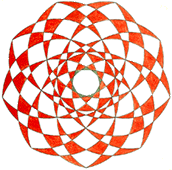
|
Remo F. Roth
Dr. oec. publ., Ph.D.
dipl. analyt. Psychologe (M.-L. v. Franz)
|
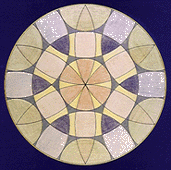
|
©
2004 by Pro Litteris, Zurich, Switzerland and Remo F. Roth, Horgen-Zurich. All
Rights Reserved. dr.remo.roth@psychovision.ch.
Republication and redissemination of the contents of this screen or any part of
this website are expressly prohibited without prior psychovision.ch written
consent.
With many thanks to Gregory Sova, Ph.D.
(LA, CA) for
translation assistance
Some
Thoughts about the Relationship of Carl Jung’s Depth Psychology
to Quantum Physics and to Archetypal Psychosomatics
Lecture
in Rome, Italy for the Presentation
of my Book I Cercatori di
Dio [The Quest for God],
October 14th, 1994
(Part 1)
Motto:
"There
is no God,
and
Paul Dirac is his prophet“
(Wolfgang
Pauli)
Remark
for the revised English translation:
Since my
lecture in Rome, Italy in the year 1994 my insights about the
relationship of Carl Jung’s depth psychology, quantum physics
and archetypal psychosomatics and psychophysics have developed further. Therefore I
share here some sort of a work in progress, i.e., I have entered new
information which show my progress in dealing with
the subject between the years 1994 and 2003.
Contents:
Part 1:
1.
Some of the most important contents of my book I Cercatori di Dio [The Quest for God]
1.1
The God-image of mysticism and the synchronistic consciousness
Part 2:
1.2
The projection of the Eros consciousness into the accelerator
1.3
The renewed God-image appears in the bubble chamber
Part 3:
2.
The Kappa synchronicity, Paul Dirac’s antimatter and the
negative energy
2.1
The first event of the Kappa synchronicity
2.2
The second event of the Kappa synchronicity
3.
Archetypal psychosomatics
Some Thoughts about the Relationship of Carl Jung’s Depth
Psychology to Quantum Physics and to Archetypal Psychosomatics
(Part
1)
|
"Jung
found further that the mandala does not only mirror an
inner state of order, but that its harmony or disharmony
encompasses also the surroundings of the individual. Thus
a mandala needs a symbol in which the outer and inner
world merge. There is for Jung a ultimate reality beyond
matter and psyche which he called the unus mundus, its
empirical manifestation is the principle of synchronicity
because in synchronistic events the inner world behaves as
if it were outside and the outer world as if it were
inside. As the mandala symbolism expresses the holistic
order of matter and psyche it should have been
investigated by physicists as well as psychologists
because the mandala reappears in their hypothetical models
of the atomic world. The atomic model of Niels Bohr is
already a cosmic mandala and the models which the
physicists construct nowadays to visualize the quarks are
also mandalas. It is therefore a merit of Dr. Remo Roth's
book to pick up that neglected subject which is of the
utmost importance, and I hope that it will provoke further
widespread serious discussion of the subject."
From
the foreword by Marie-Louise
von Franz
|
1.
Some of the most important
contents of my book I Cercatori di Dio [The
Quest for God]
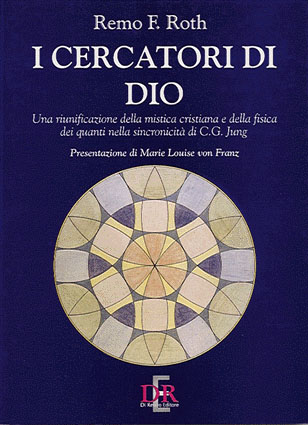
Ladies
and Gentlemen
I
thank you for your readiness to listen to my remarks about my book
I Cercatori di Dio
[German original: Die
Gottsucher; suggested English title: The
Quest for God]. In the first part [section 1] I will talk about
some of the most important ideas of my book.
Subsequently
[section 2], I would like to show you through a living example,
how I apply the new ideas deduced therein to me and to my creative
activity. I will thus tell and interpret for you a synchronicity
from my own life. You will see in such a manner, how the
preconscious knowledge of the objective psyche (the collective
unconscious of C.G. Jung) led me onto the track of these new
personal breath-taking discoveries. Concerning these, they are
described in my just published new book Hat
AIDS einen Sinn? (Does
AIDS Have Meaning?), on which I will report in the third part
[section
3] of my lecture.
1.1
The God-image of mysticism and the synchronistic consciousness
My
book Die Gottsucher (The Quest for
God), which is published today in its Italian translation I
Cercatori di Dio begins with the ideas and actions of a
power-possessed Christian dogmatism, which condemned the creative
ideas of the Gnostics and mystics. The climax of this destructive
development was the burning of their writings organized by the
bishop Irenaeus of Lyon in the year 170 AD. But as the unfolding
of history shows, these ideas established themselves nevertheless
in the underground of occult practices as found for example in
ancient Alchemy. These ideas began to blossom again in the alchemy
of the Middle Ages, and also today, at the end of the Christian
eon. Namely, they came back anew during the 20th
century in Carl G. Jung’s depth psychology as well as in a very
astonishing way in quantum physics, thus embedded in a historical
synchronicity.
But
let us start at the beginning: The official representatives of
Christianity, the popes and church fathers, had definitively
formulated toward the end of the fourth century the idea of the
Trinity. In their concept God is composed therein of a three-fold
unity, built up by the three persons of: God the father, God the
son, and God the Holy Spirit. The most important aspect of such a
three-fold unity is the fact, that in it the three persons are
identical in character. Expressed in the terms of today’s
science this means the implicate recognition of the fact that the
God-image must be formulated as an energetic principle [see also The
New Mysticism…, section 8.5].
Seen
from a qualitative point of view, a third principle can only
develop from the union of the opposites
- of the one and the
other. The compelling conclusion from this fact is the paradoxical
statement that the Trinity must also be an ambivalent twoness.
This necessary qualitative step the church fathers could not
fathom. On the contrary, they resisted with all available
instruments of power against the acknowledgment of the ambivalence
of the God-image. Their third principle, the Holy Spirit, became
therefore a purely spiritual reflection of the masculine
principle; its dark shadow which reflects the feminine principle
was repressed.
[January
2004: The expression "dark" does of course not mean
"evil". As Wolfgang Pauli has clearly shown in his
letters (see f.i. Carl
Jung's Quaternity, Neoplatonic Philosophy..., part 4),
after the birth of natural science in the 17th century,
"dark" was more and more identified with
"acausal", "indeterministic". For the novel
scientific consciousness, which was governed by the idea of the
power over nature, i.e., a control over it with the help of the
causal mathematical laws of Newton, acausality, the principle of
the Medieval Word Soul, became more and more the principle of Evil
per se.]
Such
a definition of the Trinity of God by the Church Fathers stands
however in stark contrast to the original, preconscious
predisposition of the God-image in man. The archetypal background
of the Trinity consists therefore in a definition, in which also
the qualitative aspect, i.e., the ambivalent twoness, is enclosed.
This
inability of the church fathers to accept the Gnostic definition
of the God-image as an ambivalent twoness caused the historical
fact that the archetypal background of the Trinity, the ambivalent
twoness, was only able to establish itself unconsciously, as some
sort of a shadow of the Holy Spirit. The first climax of this
development we see in Hermetic alchemy [see also Hermetic alchemy],
whose central symbol, the spirit Mercury, exists as a downright
ambivalent twoness: Mercury is bright and dark, good and evil,
spirit and matter – briefly: a union of the opposites (Jung,
CG, CW 13, §§ 239).
Since
the Church Fathers had already differentiated the Christian
God-image into a Trinity, it was now no longer possible to imagine
the divinity, as the early Christian Gnostic perceived
it, as an ambivalent father/mother. The post-Trinitarian
God-image must therefore consider both, the structure of the
Trinity as well as the ambivalent twoness of the Divine. The
logical consequence of such a union of the qualitative and the
quantitative aspect of the Trinity is therefore a God-image that
corresponds to the structural principle of a double Trinity –
the Seal of Solomon or Star of David.
[Remark
of January 2004: When I wrote The
Quest for God in the years 1981 to 1986, I did not yet know
the fact that the physicist and Nobel laureate Wolfgang Pauli was
persecuted in his dreams and visions by this double-triadic
God-image. When I began to read his Wissenschaftliche
Briefwechsel (The
Scientific Correspondence),
I realized that at least after the year 1948 he
should have become conscious about the fact that the preconscious
knowledge of the collective unconscious wanted to show him with
these dreams and visions that the archetypal background of the
energy term is ambivalent.
The
necessary conclusion of this archetypal fact is the definition of
a modern energy term, which follows the bipolarity of the Taoist
yang/yin. In physical terms this means that besides the positive
energy - corresponding to the Taoist yang or masculine principle
-, we must include the concept of negative energy, i.e., yin or
feminine energy, too, though
such energy behaves, as physics
tells us and we will see later, absolutely non-physically.
This conclusion means, too, that Paul A. Dirac, when defining
antimatter as a replacement of the negative energy, did not follow
the archetypal pattern that constitutes the preconscious
background of the energy term (further explanations see also
below).]
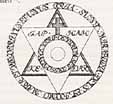 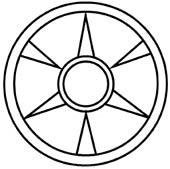 According
to the Jewish myth researcher Gershom Scholem, the Seal of Solomon
is not originally Jewish. It entered the Judaism relatively late,
i.e., only in the early Middle Ages[i].
However, the double-triadic image of God emerges also in the
Christian mysticism. More than 500 years ago, at the beginning of
the renaissance, the Swiss Saint Nicholas von Flue transformed his
frightening vision of God’s face into his today famous Radbild,
the image of the wheel [see The
Wheel Image… and The
New Mysticism…;
see figure on the right] the double-triadic and
therefore absolutely non-orthodox structure is obvious. According
to the Jewish myth researcher Gershom Scholem, the Seal of Solomon
is not originally Jewish. It entered the Judaism relatively late,
i.e., only in the early Middle Ages[i].
However, the double-triadic image of God emerges also in the
Christian mysticism. More than 500 years ago, at the beginning of
the renaissance, the Swiss Saint Nicholas von Flue transformed his
frightening vision of God’s face into his today famous Radbild,
the image of the wheel [see The
Wheel Image… and The
New Mysticism…;
see figure on the right] the double-triadic and
therefore absolutely non-orthodox structure is obvious.
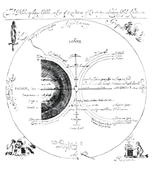 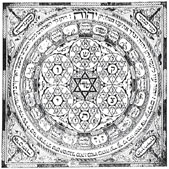 A
little later we find it in the alchemy of Paracelsus [see figure
above left], who however
thought of it as of a Jewish origin. In a very special version we
see it in the Mandala of the German Mystic Jakob Boehme [see
figure on the right (or in Jung, GW 9/I, p. 317)]. Further, we
encounter
it
in the Jewish Kabbalah [see image on the left], in Sufism, i.e., in the Islamic
mysticism, and also in the Buddhist and Hindu mysticism, the
Tantrism [see image right below]. In all these five world religions the Seal of Solomon
symbolizes the “unifying symbol” (Carl G. Jung), and it is
without any exception assigned to the human heart, the place where
the mystical A
little later we find it in the alchemy of Paracelsus [see figure
above left], who however
thought of it as of a Jewish origin. In a very special version we
see it in the Mandala of the German Mystic Jakob Boehme [see
figure on the right (or in Jung, GW 9/I, p. 317)]. Further, we
encounter
it
in the Jewish Kabbalah [see image on the left], in Sufism, i.e., in the Islamic
mysticism, and also in the Buddhist and Hindu mysticism, the
Tantrism [see image right below]. In all these five world religions the Seal of Solomon
symbolizes the “unifying symbol” (Carl G. Jung), and it is
without any exception assigned to the human heart, the place where
the mystical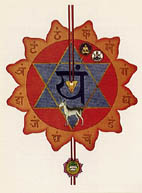 relationship of man with God takes place. relationship of man with God takes place.
In
Christian mysticism the Seal of Solomon compensates the purely
masculine or spiritually
dogmatized God-image, the latter totally
detached from matter. In the Seal of Solomon spirit and matter are however
unified in what Carl Jung called the objective psyche or the
collective unconscious. Further it is a symbol of its center, the
Self (C.G. Jung), which itself corresponds to the preconscious
God-image naturally included in the human soul. Therefore it
symbolized also the lapis (the stone), the goal of the alchemical Opus (work).
[Remark
of January, 2004: Since I wrote these phrases in the year 1994, I
have seen that behind Carl Jung’s Self – I call it the Logos
Self – there must exist another realm, the Eros unconscious with
its center, the Eros Self. This  differentiation is insofar
important as Carl Jung’s objective psyche is a masculine
principle, as is the (Logos-) Self defined by him. The necessity
of a bipolar structure of the collective unconscious comes from
the fact that – as mentioned above – the archetypal background
of the energy term is bipolar. Therefore, also the term “psychic
energy” must have this bipolar aspect. The best realization of
this archetypally and preconsciously prefigured energy concept is the yang/yin
bipolarity of Taoism {see
also The
Seal of Solomon…}.
] differentiation is insofar
important as Carl Jung’s objective psyche is a masculine
principle, as is the (Logos-) Self defined by him. The necessity
of a bipolar structure of the collective unconscious comes from
the fact that – as mentioned above – the archetypal background
of the energy term is bipolar. Therefore, also the term “psychic
energy” must have this bipolar aspect. The best realization of
this archetypally and preconsciously prefigured energy concept is the yang/yin
bipolarity of Taoism {see
also The
Seal of Solomon…}.
]
As
I showed in The Quest for God, the qualitative view of the
third and thus the Seal of Solomon resolves also the famous
alchemical axiom of Maria Prophetissa: “One becomes two, two
becomes three, and out of the third comes the One as the
fourth” (see for example Jung, CG, CW
13, § 187, note 81). If we include the ambivalence, or better,
the bipolarity of the third, the fourth is not anymore equal to
number 4, but to the Seal of Solomon, to 2x3 or to number 6.
This
fourth, the Seal of Solomon, establishes the union of the
spiritual and the material Triad (or Trinity) of the God-image. As
a consequence of the empirically observable synchronicity
principle, Carl G. Jung recognized in his latter years that behind
our artificial split into matter and spirit there must be a
unified world. For its characterization he used the term unus
mundus by the Medieval alchemist and student of Paracelsus,
Gerardus Dorneus. Alchemy imagined this unus
mundus as a potential reality before the Genesis, out of which
a new creation is possible at any time (the so-called creatio continua).
[Remark
of January 2004: Carl Jung began to deal with the unus mundus as a symbol of the Self, stated by him as the center of
the collective unconscious, because of the empirical fact that
synchronicities exist, which seem – at least for a short moment
of time - to unify matter and spirit in the soul of the
individual. As Wolfgang Pauli first discovered, the revolutionary
pioneer of depth psychology created by this an opposition between
two different epistemological models. On the one hand, his theory
of the archetypes is causal or deterministic – best exemplified
in his book AION (CW 9/II), in which he shows the causal
development of the Self archetype during the Christian eon -, on
the other acausal or indeterministic like his
synchronicity theory. Metaphorically seen, we can therefore
compare this inconsistency with a mixture of Newtonian and quantum
physics – an epistemological deficiency which is desperate to be
eliminated in the near future. ]
Carl
Jung was convinced that the Mandala symbolizes the
depth-psychological and therefore empirically observable
equivalent of the unus
mundus, as well as the lapis
and the Microcosm are its alchemical equivalent (CW 14, § 661).
[Remark
of January, 2004: Carl Jung accepted
however only the quaternarian Mandala as a symbol of the Self.
Therefore there exists a conflict between his definition of the
God-Image as a quaternity, and the definition of the God-image as
the Seal of Solomon. As I show in Neoplatonic
and Hermetic Alchemy… , this difference is
based on the fact that also alchemy was – as Wolfgang Pauli has
first seen - split in two different branches: One with Neoplatonic
roots, experienced especially by theologians and priests, and the
other one with Hermetic roots, exercised especially by the
alchemical physicians (with Paracelsus, Dorneus, Robert Fludd as
the most important of them). The Neoplatonic Mandala was the
quaternity, the Hermetic however the Seal of Solomon.]
The
depth psychologist postulated further that the synchronistic
experience is the empirically observable parapsychological aspect
of the unus mundus. The
possibility of the observation of synchronicities exists however
only when we accept a change of our consciousness. We must first
complete the standpoint of extraverted observation by the
introverted. In this way also the consciousness gets an ambivalent
aspect: It sees and hears at the same time outward and inward.
The
empirical expression of the introverted completion is the
observation of our dreams. A human that has made this habit to
their inner process, will see that after experiencing a dream more
and more events in the outside occur that correspond in their
content and meaning to it. Extracting the meaning of such
synchronicities liberates the potential spiritual creation hidden
in the unus mundus. Like
this, by the effort of the human consciousness, a new potential
creation has been realized. Such a conscious realization changes
the attitude of the consciousness and sometimes also of the
collective. In the latter case, a so-called exchange of the
paradigma has happened.
Such
a renewed consciousness I call a synchronistic one. It is already
constellated for at least 500 years, i.e., since Nicholas von Flue,
where it is symbolized in his Radbild
[the image of the wheel; see also
The
Wheel Image…].
The
historical development ran however in another direction: Towards
the middle of the 17th century, René Descartes
introduced the sharp separation of spirit and matter, from res cogitans and res extensa, from the inside and outside, whose catastrophic effects
we realize more and more clearly today. Natural science, too,
followed this development and concluded that for the scientific behavior
the observation of the outside is sufficient, and it did
not require help from the inner condition of the observer,
of his soul, anymore. Its point
of view is therefore purely extraverted;
introversion and introspection have therein no place.
go
to part 2
further
English articles see in
English
Homepage Remo F. Roth
back

|